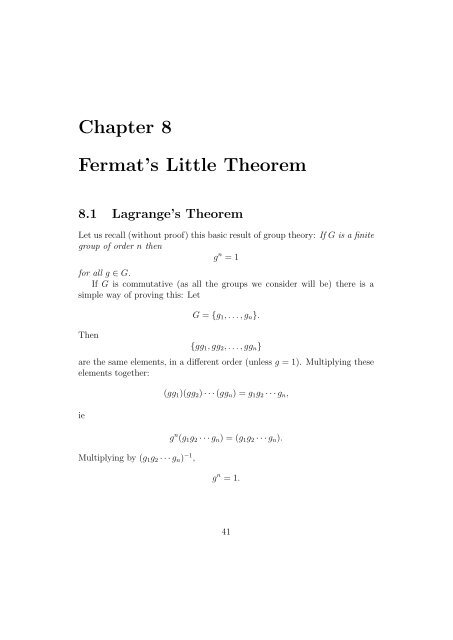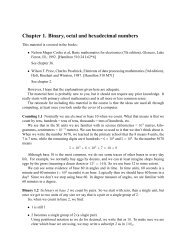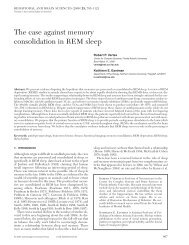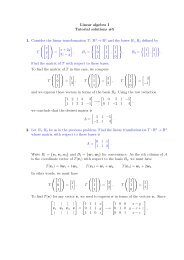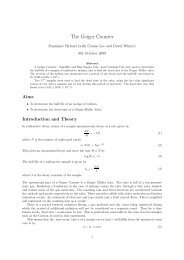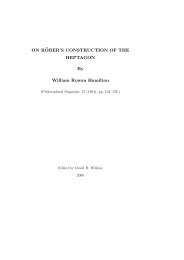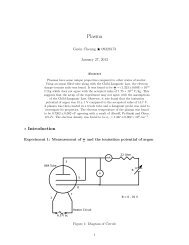Chapter 8 Fermat's Little Theorem
Chapter 8 Fermat's Little Theorem
Chapter 8 Fermat's Little Theorem
Create successful ePaper yourself
Turn your PDF publications into a flip-book with our unique Google optimized e-Paper software.
<strong>Chapter</strong> 8<br />
Fermat’s <strong>Little</strong> <strong>Theorem</strong><br />
8.1 Lagrange’s <strong>Theorem</strong><br />
Let us recall (without proof) this basic result of group theory: If G is a finite<br />
group of order n then<br />
g n = 1<br />
for all g ∈ G.<br />
If G is commutative (as all the groups we consider will be) there is a<br />
simple way of proving this: Let<br />
Then<br />
G = {g 1 , . . . , g n }.<br />
{gg 1 , gg 2 , . . . , gg n }<br />
are the same elements, in a different order (unless g = 1). Multiplying these<br />
elements together:<br />
ie<br />
Multiplying by (g 1 g 2 · · · g n ) −1 ,<br />
(gg 1 )(gg 2 ) · · · (gg n ) = g 1 g 2 · · · g n ,<br />
g n (g 1 g 2 · · · g n ) = (g 1 g 2 · · · g n ).<br />
g n = 1.<br />
41
42<br />
8.2 Euler’s <strong>Theorem</strong><br />
<strong>Theorem</strong> 8.1 (Euler’s <strong>Theorem</strong>). For all x coprime to n,<br />
x φ(n) ≡ 1 mod n.<br />
Proof. The group (Z/n) × has order φ(n).<br />
Lagrange’s <strong>Theorem</strong>.<br />
The result follows on applying<br />
8.3 Fermat’s <strong>Little</strong> <strong>Theorem</strong><br />
As a particular case of Euler’s <strong>Theorem</strong>, since φ(p) = p − 1 if p is prime, we<br />
have<br />
<strong>Theorem</strong> 8.2 (Fermat’s <strong>Little</strong> <strong>Theorem</strong>). If p is prime then<br />
for all x coprime to p.<br />
x p−1 ≡ 1 mod p<br />
The title ‘Fermat’s <strong>Little</strong> <strong>Theorem</strong>’ is sometimes given to the following<br />
variant.<br />
Corollary 8.1. If p is prime then<br />
for all x.<br />
x p ≡ x mod p<br />
Proof. If p ∤ x the result follows on multiplying the congruence in the <strong>Theorem</strong><br />
by x. If p | x then trivially x p ≡ 0 ≡ x mod p.<br />
8.4 Carmichael numbers<br />
Fermat’s <strong>Little</strong> <strong>Theorem</strong> suggests a simple test for the primality of n: Is<br />
x n ≡ x mod n for all x?<br />
This is sometimes known as Fermat’s Primality Test.<br />
Example: Take n = 6, for example. The congruence obviously holds for<br />
x = 0, 1. But for x = 2,<br />
2 6 = 64 ≡ 4 mod 6,<br />
so the test fails, and we have proved that 6 is not prime.<br />
Unfortunately, it turns out that some composite numbers can satisfy Fermat’s<br />
test for all x.<br />
Definition 8.1. We say that n ∈ N is a Carmichael number if n is composite<br />
but<br />
x n ≡ x mod n for all x.<br />
Example: The smallest Carmichael number is<br />
561 = 3 · 11 · 17.
43<br />
To see that 561 is a Carmichael number, note that 3 − 1 = 2, 11 − 1 = 10<br />
and 17 − 1 = 16 all divide 561 − 1 = 560.<br />
Suppose first that x is coprime to 561. By Fermat’s <strong>Little</strong> <strong>Theorem</strong>,<br />
Similarly,<br />
x 2 ≡ 1 mod 3 =⇒ x 560 ≡ 1 mod 3<br />
x 10 ≡ 1 mod 11 =⇒ x 560 ≡ 1 mod 11,<br />
x 16 ≡ 1 mod 17 =⇒ x 560 ≡ 1 mod 17.<br />
Putting these together, we deduce that<br />
x 560 ≡ 1 mod 3 · 11 · 17 = 561 =⇒ x 561 ≡ x mod 561.<br />
But what if x is not coprime to 561, say 17 | x but 3, 11 ∤ x?<br />
x = 17y, where gcd(y, 33) = 1.<br />
The congruence is trivially satisfied mod 17:<br />
Then<br />
So we only have to show that<br />
(17y) 561 ≡ 17y mod 17.<br />
(17y) 561 ≡ 17y mod 33,<br />
Now φ(33) = 2 · 10 = 20. Since 17 and y are coprime to 33, it follows by<br />
Euler’s <strong>Theorem</strong> that<br />
Hence<br />
17 20 ≡ 1 mod 33 and y 20 ≡ 1 mod 33.<br />
(17y) 20 ≡ 1 mod 33 =⇒ (17y) 560 ≡ 1 mod 33<br />
=⇒ (17y) 561 ≡ 17y mod 33.<br />
The other cases where x is divisible by one or more of 3, 11, 17 can be<br />
dealt with similarly.<br />
We shall prove the following result later. The argument is similar to that<br />
above, but requires one more ingredient, which we shall meet in the next<br />
<strong>Chapter</strong>.<br />
Proposition 8.1. The number n is a Carmichael number if and only if it is<br />
square-free, and<br />
n = p 1 p 2 · · · p r<br />
where r ≥ 2 and<br />
for i = 1, 2, . . . , r.<br />
p i − 1 | n − 1<br />
There are in fact an infinity of Carmichael numbers — this was only<br />
proved about 10 years ago — although they are sparsely distributed. (There<br />
are about N 1/3 Carmichael numbers ≤ N.)<br />
Note that if a number fails Fermat’s test then it is certainly composite.<br />
The converse is not true, as we have seen; a number may pass the test but<br />
not be prime.
44<br />
However, Fermat’s test does provide a reasonable probabilistic algorithm,<br />
for determining “beyond reasonable doubt” if a large number n is prime:<br />
Choose a random number x 1 ∈ [2, n − 1], and see if<br />
x n 1 ≡ x 1 mod n.<br />
If this holds, then the chances of n being prime are certainly much better<br />
than they were before. Far fewer than 1/2 of composite numbers satisfy this<br />
congruence. So one could say that the odds of the number being prime are<br />
at least doubled.<br />
Now repeat the test with a second random number x 2 ∈ [2, n − 1] and<br />
repeat the test. There is no reason to suppose that there is any statistical<br />
relation between the two tests; so if the test is passed again, the chances of<br />
the number being prime are at least 4 times as great.<br />
If we repeat the test 20 times, say, and n passes each time, we may say<br />
that the number is “virtually certain” to be prime.<br />
Having said all that, Fermat’s test is never used in practice, because there<br />
is a simple variant which avoids the Carmichael number problem, and has<br />
other advantages as well.<br />
8.5 The Miller-Rabin test<br />
Suppose p is an odd prime. Let<br />
p − 1 = 2 e m,<br />
where m is odd.<br />
Suppose p ∤ x. Then we know that<br />
x p−1 = x 2em ≡ 1 mod p.<br />
But this may be written<br />
( ) 2<br />
x 2e−1 m ≡ 1 mod p.<br />
It follows that<br />
x 2e−1m ≡ ±1 mod p;<br />
for Z/(p) is a field; so if x ∈ Z/(p) then<br />
Now suppose<br />
x 2 = 1 =⇒ (x − 1)(x + 1) = 1 =⇒ x = ±1<br />
x 2e−1m ≡ 1 mod p.<br />
Then we can repeat the argument, if e > 1, to see that<br />
x 2e−2m ≡ ±1 mod p.<br />
Continuing in this way, we see that either<br />
for some i ∈ [0, e − 1]. or else<br />
x 2im ≡ −1 mod p<br />
x m ≡ 1 mod p.<br />
That is the Miller-Rabin test. It turns out that if a number n passes the<br />
test for all x coprime to n then it must be prime; there is no analogue of<br />
Carmichael numbers.<br />
But we shall need the results of the next chapter to establish this . . . .


